Because today, February 2, is the great Feast of the Presentation of Christ in the Temple, perhaps you might enjoy reading my slightly silly but actually very serious old Post relating the true story of …
______________________________________
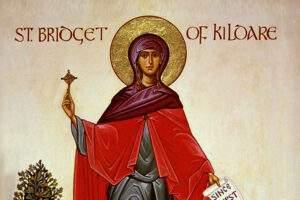
Now to today’s subject: Saint Brigid (or Bridget or Bridgit or Brid or Bride *) of Ireland, whom we commemorated yesterday on February 1.
- We’re going to run into a lot of parentheses as we go along here. Many Irish saints and places seem to have had double or even triple or quadruple spellings. I’ll try to keep this straight, but I make no promises. For purposes of this Post I’ll stick with “Brigid”.
It’s a long way from Constantinople (Istanbul), where we were in last week’s Post, to Ireland – 3,702 kilometers (2,300 miles ). By ship in the ancient world, that took three weeks’ travel under favorable conditions, and the Atlantic could be treacherous. The Roman Empire had stopped on the west coast of Great Britain, at the edge of the Irish Sea. Ireland lay beyond that, ‘way out at the western edge of the known world. Back in the Great City Constantinople, almost nothing was known about that lovely island. Nevertheless, by the Fifth Century a lot was going on out there.
For one thing, Saint Patrick, patron saint of Ireland, was in process of converting the Irish from paganism to Christianity. You can read about that in many places, including here: https://frbillsorthodoxblog.com/wp-admin/post.php?post=3622&action=edit
At the same time, Saint Brigid was becoming another much beloved patron * saint of Ireland.
- Shouldn’t female “patron saints” be called “matron saints”? Just asking.
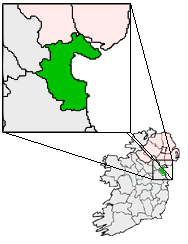
Saint Brigid was born in the year 450 in County Louth on the east coast of Ireland into a pagan household in Faughart, about two miles from Dundalk. Her father was Dubthach and her mother Brocessa (or Broiseach), one of his slaves. Brigid was named after the popular Celtic * goddess Brigid.
- For you Boston Celtics fans: In the old country it’s pronounced “Keltic”.
Even as a child, Brigid gave her father a lot of trouble. She kept giving things away to the poor: food, clothing, and even her father’s prized possessions. He thought he was going to go broke if she kept this up. His solution? He would sell her to the king, who he was sure would take her, because she was a pretty girl with beautiful long red hair. So one day he took Brigid to the king’s court, leaving her outside to wait while he dickered with His Majesty about the price. The king asked to see the girl, so Dubthach led him outside, just in time to see her give away her father’s sword to a beggar – a sword which had been presented to him by the king! The king said “I will not buy a girl who values us both so little.”
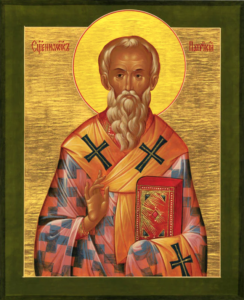
How Brigid became a Christian is not clear. Some say her father and his family came to the Faith. Some say she was converted later by the preaching of Saint Patrick himself (also spelled “Patricius” or “Pádraig” or “Padrig” *)
- You can’t say I didn’t warn you.
We do know that Brigid received monastic tonsure at the hands of Saint Mael (or Mel or Moel) of Ardagh, who was a nephew of Saint Patrick. Just in case you were wondering, Mael was the son of Conis (or Chonis or Chonas) and Patrick’s sister Saint Darerca, who out of her two marriages was said to have borne seventeen sons, all of whom became bishops!
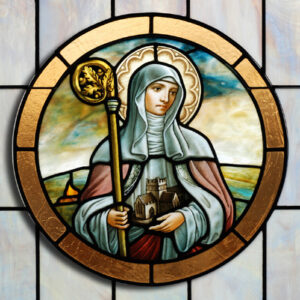 Soon after this, about the year 470, Brigid built a cell for herself on property given to her by the King of Leinster. The land came to be called Kildare (Cill-Dara, Kildara, Kildarra, Cildara, Cildore), which meant “the church of the oak”, because her cell was located beneath a great ancient oak tree. Soon many others, both men and women, followed her. This was the beginning of cenobitic (communal) monasticism in Ireland. Kildare was a “double monastery” for both nuns and monks, who lived in separate quarters, of course. * Saint Brigid was abbess of the entire monastery, both women and men, where she was noted for her common sense and holiness. From there she traveled about Ireland, establishing many monasteries.
Soon after this, about the year 470, Brigid built a cell for herself on property given to her by the King of Leinster. The land came to be called Kildare (Cill-Dara, Kildara, Kildarra, Cildara, Cildore), which meant “the church of the oak”, because her cell was located beneath a great ancient oak tree. Soon many others, both men and women, followed her. This was the beginning of cenobitic (communal) monasticism in Ireland. Kildare was a “double monastery” for both nuns and monks, who lived in separate quarters, of course. * Saint Brigid was abbess of the entire monastery, both women and men, where she was noted for her common sense and holiness. From there she traveled about Ireland, establishing many monasteries.
- No one had yet invented today’s “co-ed dorms”, with girls and boys living on the same floor. Thank God.
It’s time to bring up the subject of “Celtic Christianity”. The early Church in Ireland and Great Britain was not Roman Catholic, at least certainly not in today’s sense. (Of course, at the time the Church in Rome was not Roman Catholic in today’s sense, but let’s not go there now.).
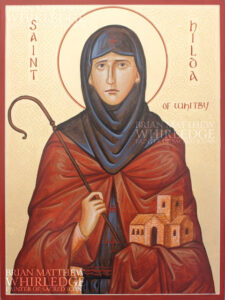
Celtic Christianity was fully Orthodox (“Catholic”, if you wish), but it functioned in its own peculiar way. So nearly as we can tell, the diocesan structure wasn’t significant. The centers of authority were the monasteries, the abbesses and abbots, * which meant that some women often had much more authority than under the Roman Catholic and Eastern Orthodox diocesan structures. In 597 Pope Gregory the Great sent Saint Augustine to get things in the British isles “normalized”. In 664 at Whitby Abbey in the north of England (another Celtic-style women’s and men’s monastery), the Abbess Saint Hilda presided over the famous “Synod of Whitby”, which by vote decided that Britain should go under the authority of the Church of Rome. However, the Church in Ireland did not go Roman Catholic till at least the Twelfth Century.
- Bishops existed in Celtic Christianity but seem to have been used for the purposes of ordinations and not much else. I once heard this described in a very crude way, which I’m not going to tell you. Some claim Saint Brigid was a bishop. She wasn’t. However, as I said, she held more real authority than any Irish bishop.
Back to the story: Saint Brigid lived in a time of great turmoil in Western Europe. Just as Ireland was becoming Christian, pagan Vandals and Goths and Huns were moving south and west into Gaul and Italy, even as far as Spain. Far to the west Ireland was spared all this and quickly became a center of Christian learning and piety which preserved Christian civilization during the so-called “Dark Ages” on the Continent. * The Abbey of Kildare became one of the most prestigious monasteries in Ireland, famed throughout Christian Europe. The now long-lost illuminated manuscript of the Book of Kildare was created there.
- Have you read How the Irish Saved Civilization by Thomas Cahill? It’s a popular book, not a scholarly one, and I think Cahill goes over the edge in a few respects, so be careful, but it tells the basic story well in an easily readable way, and with pictures!
Now, where were we? Oh, yes, Saint Brigid.
Mother Brigid was famed as a Wonderworker, though I find her miracle stories kind of hard to pin down. Some of them seem fanciful to me, like the one about how she once hung her cloak on a sunbeam. She was said, like the goddess Brigid, to provide milk and cream adequate for all situations. I wonder if people got her and the goddess confused.
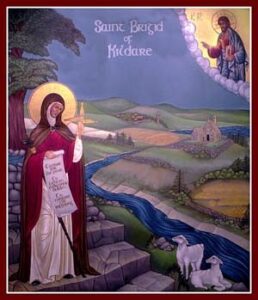
There is another story about the blind nun named Dara who was sitting with Brigid who was trying to tell her of the beauties of the rising sun over the landscape. Then, for lack of words adequate to describe it, Brigid made the sign of the Cross over Dara’s eyes and restored her sight. The nun took in the loveliness for a while, and then said, “Please, Mother, close my eyes again. Seeing all this beauty with my eyes keeps me from seeing God with my soul.” Saint Brigid did as the nun asked.
Yet another story tells of how (imitating her Lord – well, in a way) Saint Brigid once turned water into beer for a large group of visiting clergy. Now, that’s a sensible miracle!
Even during her lifetime Brigid was regarded as a saint.
On February 1 in the year 523 Saint Brigid received Holy Communion from Saint Ninnidh of Inismacsaint (one of the “Twelve Apostles” sent out by Saint Patrick), then fell asleep in the Lord. She was buried at Kildare, but for safety her relics were transferred to Downpatrick during the later Viking invasions. It is believed she was buried in the same grave with Saint Patrick and Saint Columba of Iona. *
- I must tell you his story sometime.
As Irish missionaries were sent to rescue Western Europe from the pagan invaders, they carried devotion to Saint Brigid with them. so that at one time on the Continent at least seventy churches and monasteries were named after her. Back in Ireland a perpetual flame as a symbol of the Holy Spirit was tended in honor of Brigid for at least 1,000 years! The Diocese of Kildare was nicknamed “the see of the bishop and the virgin”. The surrounding area is now called County Kildare.
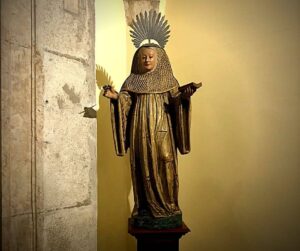
Late in the thirteenth century, Saint Brigid’s head was taken to Portugal by three Irish knights on their way to fight in the Holy Land. They left this holy relic in the parish church of Saint John the Baptist in Lumiar, about three miles from Lisbon, where it remains to this day. I don’t know if they ever explained their actions, but it was all for the best. In the Sixteenth Century, English King Henry VIII sent Lord Thomas Grey of Groby over to Ireland to deal with “the Irish problem”. * Besides massacring quite a number of Irish, Lord Grey also had the remainder of Saint Brigid’s body destroyed. (Many treasured relics of British and Irish saints were destroyed under Henry VIII, who seemed to take delight in that sort of thing.) In 1929 a small portion of Saint Brigid’s relic was transferred back to Ireland.
- As much as I love the Brits, they have done some horrible things to the Irish over the centuries. In 2011, Queen Elizabeth II paid a state visit to the Republic of Ireland and came very near to apologizing for it.
In 1969 Brigid was one of ninety-three saints removed by Pope Paul VI from the universal Roman Catholic calendar, because there isn’t sufficient contemporary documentary evidence about her * – at first causing some consternation among the many churches all around the world named after Saint Brigid!
- I’m almost tempted to mention that there are some dogmas and major feast days in the Roman Catholic Church for which there is no contemporary evidence.
Did that cause devotion to Saint Brigid to cease? No way. Her churches are still named after her and doing just fine, thank you.
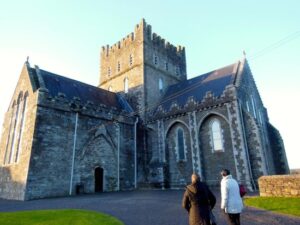



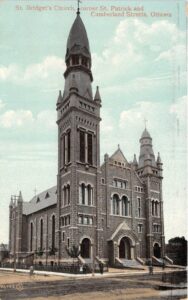
Everybody just ignored Saint Brigid’s papal revocation. Saint Brigid is still in business. That is because she, like most holy men and women, was first recognized as a saint by the people, not by the hierarchs. Only later did the hierarchs get around to officially declaring them saints. (This is still how it works in the Orthodox Church.) So, despite her formal demotion, devotion to Brigid continues as always.
In Ireland, despite the fact that Sunday Church attendance today is less than half what it was only fifty years ago, Saint Brigid continues to roll on. Most still venerate her as Ireland’s female patron saint. Because she is rightly seen as a strong woman, some take a feminist slant on her. There are a few others who, unfortunately, seem to be confusing her with the old goddess Brigid. For a full account of the situation see: https://apnews.com/article/st-brigid-1500-ireland-catholic-pagan-explain-a6a41566acca80033c3514f180d6443e
Finally, beginning only last year Saint Brigid was for the first time given this high honor!
Sources consulted in writing this Post: Orthodox Wiki, Wikipedia, orthochristian.com, johnsadinopoulos.com, the Orthodox Church in America, irelandbeforeyoudie.com, newadvent.org, Wikimedia Commons, and a few others I can’t remember.
Next Week’s Post: Saint Photios the Great
Week after Next: unless something else comes up – Papa Nicholas Planas
Paul Kingsnorth, a recent convert to Orthodoxy, and an Englishman who transplanted himself to rural Ireland (where he found Orthodoxy), had a lovely essay up this week on St. Brigid too, and he argues (and can point to recent scholarly work on the subject) that the “confusion” of Brigid with some alleged pagan goddess is yet another example of Victorian romantic neopaganism run amok and just making things up (the source of much similar mischief today where people insist, wrongly, that very Christian saints and feasts somehow must have pagan origins – an ultimately nasty way of arguing that everything Christian is somehow both inauthentic, and an example of “cultural appropriation and colonialism” by Christians).
It’s rather a shame too, that the Roman Catholic church removed her as a saint as she is one of the best attested and most influential early Christians of Ireland. One of the things Paul K. observes (and this especially struck me) is that St. Brigid, in the early records of Christians in Ireland, gets far more attention (and is better attested as an actual person), than St. Patrick. St. Anthony the Great and St. Paul of Thebes also figure more prominently than St. Patrick too.
This may be paywalled on his Substack (hopefully not), and is well worth a read.
https://paulkingsnorth.substack.com/p/mary-of-the-gael
Thank you, Skip. A number of Christian saints took over the work of pagan deities. One example: In Greece, atop many mountains there were shrines to the sun god (H)elios who rode across the sky each day in a chariot. He was replaced by Elias (in Greek pronounced almost the same as [H]elios) who ascended into heaven in a chariot, and who now has his own chapels atop the same mountains. Indeed Christ, the Light of the world, appears to have captured for Himself the Roman feast of December 25, Dies Natalis Solis Invicti, “the birthday of the unconquered sun”. Something similar seems to have happened with Saint Brigid and the Irish goddess Brigid.